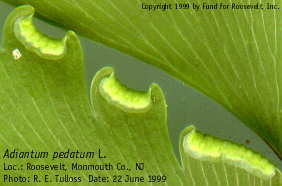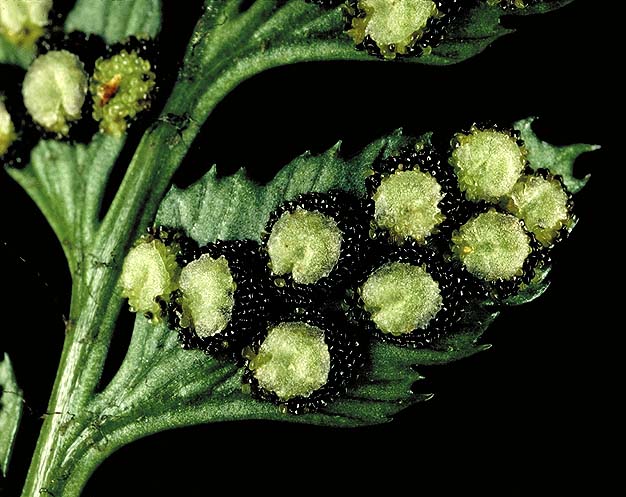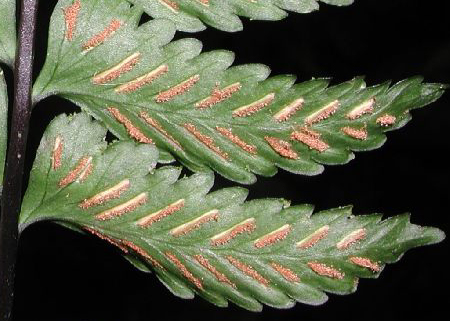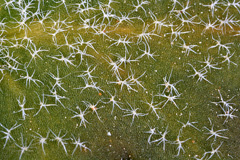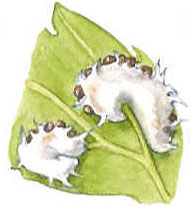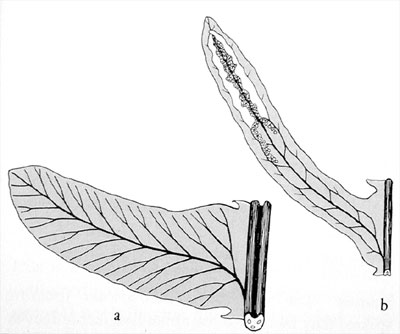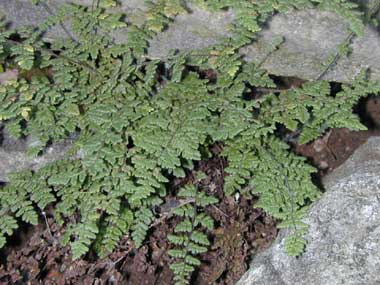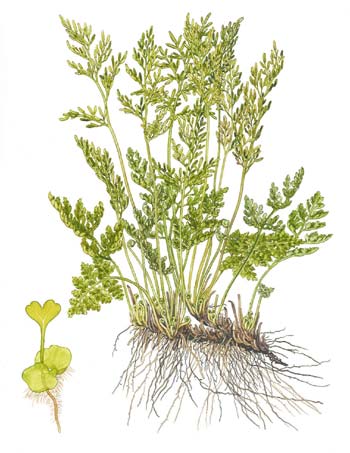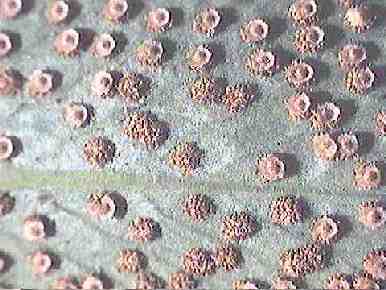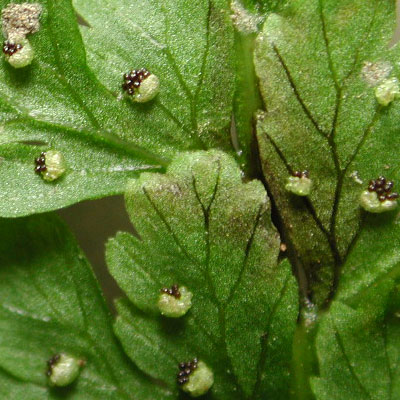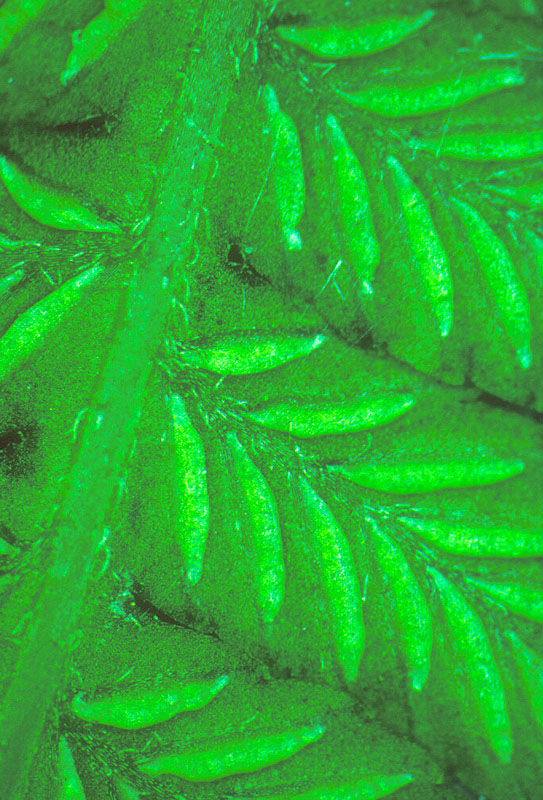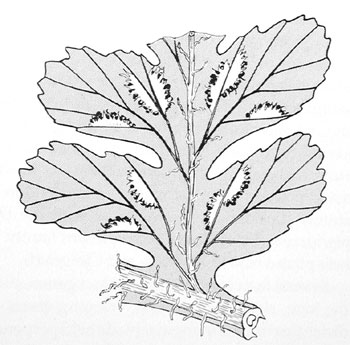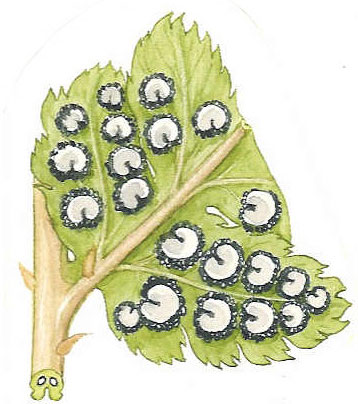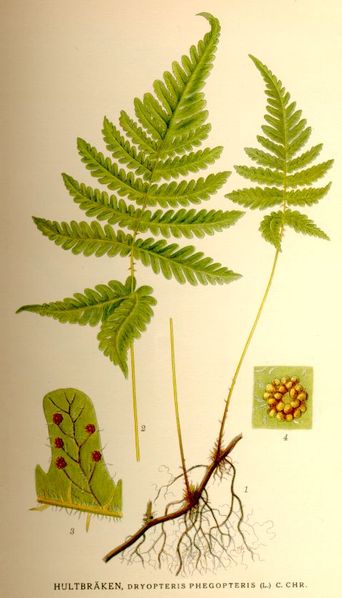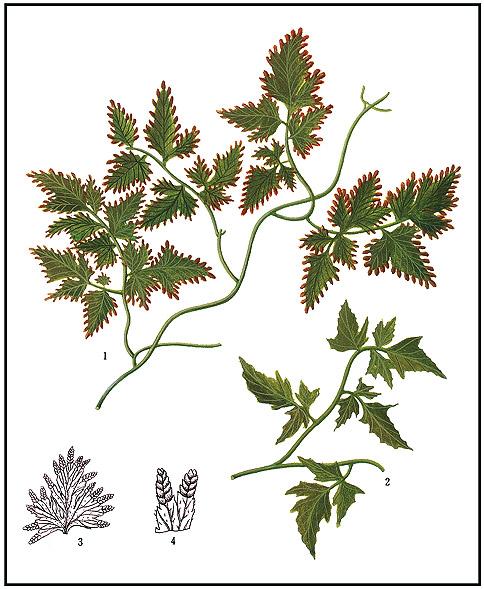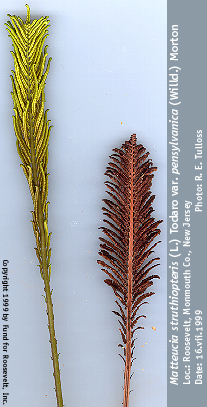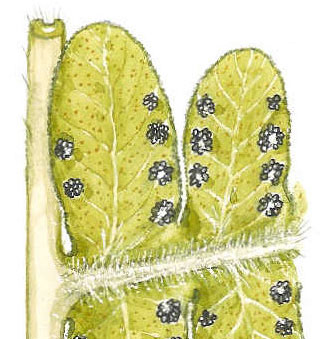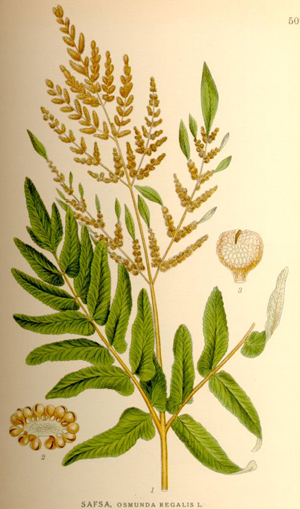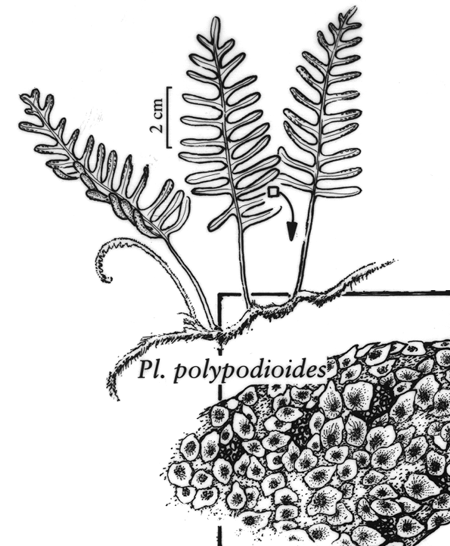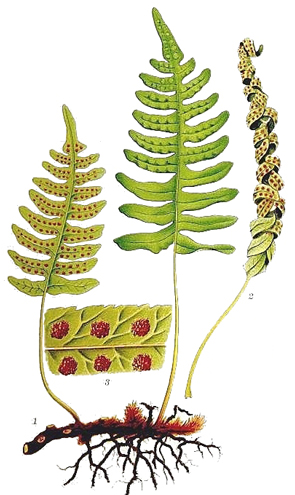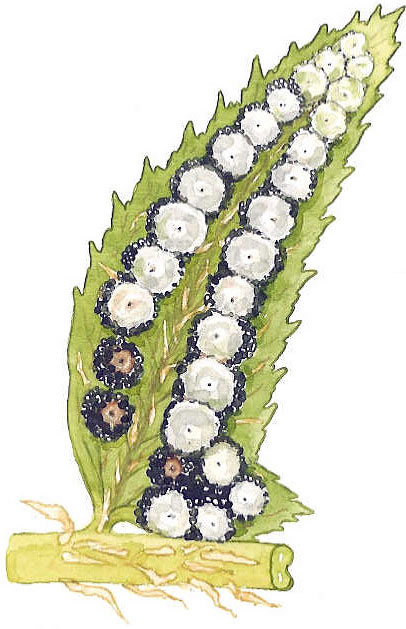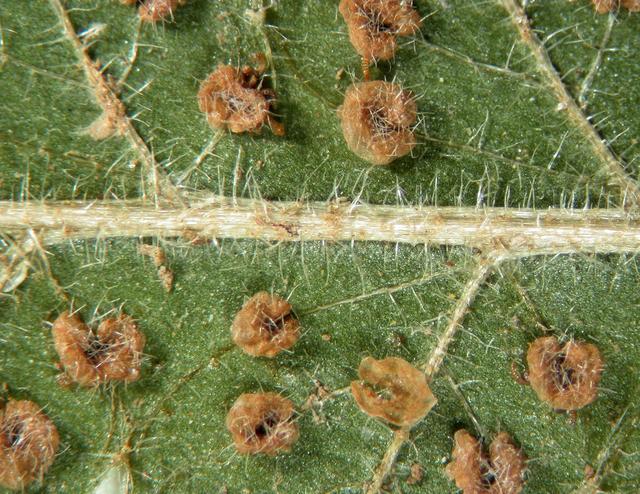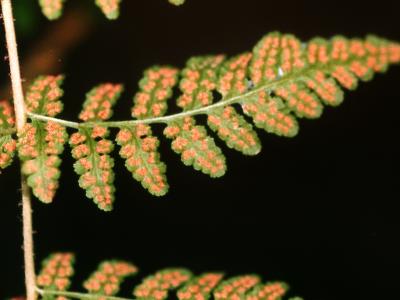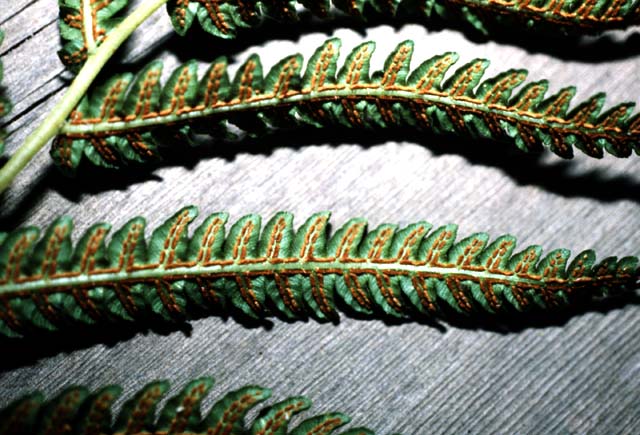| Adiantum | ||
Maidenhair fern | ||
|
Etymology
Adiantum is from the Greek, adiantos, meaning unwettable, referring to the water-repellent fronds.
Description
Rhizome: suberect to long-creeping, absent or hairy or scaly.
Frond: deciduous, monomorphic. Stipe: chestnut brown to dark purple, grooved above, glabrous or few scales, vascular bundles: 1 or 2. Blade: 1-3 pinnate or pedate, lanceolate, ovate, trowel-shaped, or fan-shaped, membranaceous to papery, commonly glabrous. segments round, fan-shaped, rhombic, or oblong with marginal teeth, lacking a midrib, veins free, forking. Sori: sporangia, submarginal, indusium: false, inrolled margins, sporangia: yellow or yellowish brown.
Distinctive Characteristics
FNA states that sporangia borne on the lower surface of the false indusium are both necessary and sufficient to define the genus. However, lacking a high-powered lens, the amateur will need additional criteria. The lack of a midrib in the ultimate segments is unique among the hardy ferns here.
|
|
|
| Arachniodes | ||
East Indian holly fern | ||
|
Etymology
From the Greek, arachnion, spider's web + odes, perhaps in allusion to a fancied resemblance of one of the more finely dissected pentagonal species, to a spider's web.
Description
Rhizome: long creeping, tan scales lanceolate.
Frond: evergreen, monomorphic. Stipe: lanceolate scales, vascular bundles: 4 or more in an arc. Blade: 2-pinnate-pinnatifid to 3-pinnate or more, deltate or pentagonal, papery to somewhat leathery, below: hairlike scales. Pinnae: anadromous, proximal pinnae largest, with basal basiscopic pinnule much larger, costae shallowly grooved above, continuous from rachis to costae, segments margins spiny, ultimate segments frequently mucronate, veins free, forked. Sori: round, between midrib and margin, indusium: reniform, attached at a sinus, sporangia: translucent.
Distinctive Characteristics
Arachniodes shares the kidney-shaped indusia and grooves continuous from rachis to costae with Dryopteris (disputed in the Flora of Australia); it differs in an anadromic plan throughout whereas Dryopteris is catadromic above the basal pinna pair, and is said to have creeping rhizomes rather than erect ones, an unconvincing distinction, given a number of species with short-creeping rhizomes in Dryopteris. A mucronate, or bristle-like, terminus at the ends of veins is also present in Arachnoides, a feature shared with many Polystichum.
|
|
|
| Aspidotis | ||
Lace fern | ||
|
Etymology
From the Greek aspidotes, shield-bearer, referring to the shield-like false indusia.
Description
Rhizome: short-creeping, scales brown to black or often bicolored with dark central stripe.
Frond: evergreen, monomorphic or nearly so. Stipe: dark reddish brown, with single groove, glabrous, vascular bundles: 1. Blade: 3-pinnate at base, or more, triangular, leathery , glabrous. segments linear, veins obscure, free. Sori: sporangia, submarginal, continuous along length of segments except at apex, indusium: false, inrolled margin, broad, thin, dry, sporangia: dark brown.
Distinctive Characteristics
Separated from Cheilanthes based on its elongate, distantly dentate, glabrous, pointed segments with striate shining surface and on its broad, thin, dry indusia.
|
|
|
| Asplenium | ||
Spleenwort | ||
|
Etymology
Greek: a, not + splen, the spleen. A totally confusing reference to the use of spleenwort to cure spleen and liver problems. The name originated with Pliny and Discorides.
Description
Rhizome: erect, scales clathrate.
Frond: evergreen, monomorphic or nearly so. vascular bundles: 2 C-shaped, back to back, uniting to 1 upwards to an X-shape. Blade: simple to 2-pinnate, commonly with tiny glandular hairs and a few linear scales. veins free. Sori: linear, indusium: thin, flap-like, covering sorus during maturation, on one side of the sorus.
Distinctive Characteristics
The stained-glass effect on rhizome scales is unique. The linear sorus along veins is characteristic.
|
|
|
| Astrolepis | ||
Star-scaled cloak fern | ||
|
Etymology
Greek: Astro, star + lepis, scale. This refers to the starlike scales on the upper blade surface.
Description
Rhizome: short-creeping, scales tan to chestnut brown, linear.
Frond: evergreen, monomorphic. Stipe: dull chestnut brown or straw-colored, rounded above, scaly, vascular bundles: 2. Blade: 1-pinnate, the pinnae varying from lobed to pinnatifid, linear, leathery, star-shaped scales on the upper surface. Pinnae: 3-6 lobes per pinna, veins obscure, free, forking. Sori: clustered near notches between pinna lobes, along veins near margin, indusium: absent, sporangia: light to dark brown.
Distinctive Characteristics
The combination of linear, pinnate leaves, two vascular bundles in the petioles, and unique star-like scales on the upper blade surface separate Astrolepis from the related Cheilanthes.
|
|
|
| Athyrium | ||
Lady fern | ||
|
Etymology
Greek: From athyrium meaning a small door. The indusium is hinged on one side.
Description
Rhizome: short-creeping or erect.
Frond: deciduous, monomorphic. Stipe: deeply grooved above, swollen at base, scaly, vascular bundles: 2, lunate, uniting to a U-shape above. Blade: 2-pinnate-pinnatifid, linear to bradly triangular, herbaceous, below: absent or of linear to lanceolate scales or 1-celled glands. costae V-grooved above, continuous from rachis to costae, segments serrate or crenate, veins veins free, simple or forked. Sori: linear or oblong or j-shaped (round), in 1 row between midrib and margin, indusium: shape of sori (absent), sinus, sporangia: brownish.
Distinctive Characteristics
Dichotomous keys are unsuccessful in keying out this genus, i.e., it is poorly circumscribed. In the main it is closest to Deparia and Diplazium, sharing with them 2 vascular bundles and rachis/costa grooves on the upper side. These two genera and most Athyrium have elongate sori. It is separated from Deparia by deeper grooves and continuity from rachis to costa vs. discontinuous in Deparia, and from Diplazium on even skimpier grounds.
|
|
|
| Blechnum | ||
Deer fern | ||
|
Etymology
Greek: Blechnum is derived from the word blechnon, which is an ancient Greek word for ferns in general.
Description
Rhizome: erect to creeping, scales brown or black.
Frond: evergreen, dimorphic, fertile leaves more erect and longer than sterile leaves. vascular bundles: more than 2 vascular bundles arranged in arc. Blade: pinnatifid to 1-pinnate, ovate, leathery, young fronds are often red. veins sterile:free, often forked; fertile: veins of fertile leaves united to form sorus-bearing secondary vein parallel to costa or costule. Sori: elongate, continuous, on both sides of the costae, indusium: flap-like, opening towards the costa.
Distinctive Characteristics
Emerging fronds in the genus are usually red or reddish, loosing the color when fully expanded.
|
|
|
| Cheilanthes | ||
Lip fern | ||
|
Etymology
Greek: From cheilos, lip + anthos, flower. A lip-like false indusium covers the sporangia.
Description
Rhizome: erect to long-creeping, scales brown to black or often bicolored with dark central stripe.
Frond: evergreen, monomorphic. Stipe: brown to black or straw-colored, rounded, flattened, or with single longitudinal groove above, hairy, scaly, or glabrous, vascular bundles: 1. Blade: pinnate-pinnatifid to 4-pinnate at base, leathery or rarely somewhat herbaceous, finely hairy and/or scaly below, finely hairy or glabrous above. segments entire, stalked or sessile, fertile segment margins slightly enrolled to cover sporangia, veins free. Sori: sporangia, submarginal, indusium: false, sporangia: brown to black or gray. |
|
|
| Cryptogramma | ||
Parsley fern | ||
|
Etymology
Greek: kryptos, hidden + gramme, line. The reflexed leaf margin hides the line of sori.
Description
Rhizome: erect to creeping, scales colorless or brownish, concolored or bicolored, ovate, lanceolate or linear.
Frond: deciduous or evergreen, dimorphic. Stipe: dark brown proximally, light brown to green distally, with single longitudinal groove above, scaly, vascular bundles: 2. Blade: 2-3 pinnate, deltate, lanceolate to elliptic, somewhat leathery or herbaceous to membranaceous, glabrous or sparsely hairy above, glabrous below. segments sterile: toothed, veins free. Sori: scattered along veins, submarginal, indusium: false, strongly enrolled, sporangia: yellow. |
|
|
| Cyrtomium | ||
Asiatic holly fern | ||
|
Etymology
Greek: kyrtoma means arch. The veins rejoin forming an arch.
Description
Rhizome: erect, large tan scales.
Frond: evergreen, monomorphic. Stipe: scaly, vascular bundles: 4 or more, in an arc. Blade: 1-pinnate, oblong-lanceolate; the blade is terminated by a pinna similar to the others, a characteristic called imparipinnate, leathery, filiform scales below, glabrous above. Pinnae: holly-like, distal pinnae only slightly smaller, costae grooves above continuous from rachis to costae, segments crenate to spinulose, veins netted. Sori: round, in 2 or more rows between midrib and margin, indusium: peltate, persistent or not, central, sporangia: brown.
Distinctive Characteristics
shares the peltate indusium with Polystichum as well as, in some cases, an upward ear at the base of the pinnae; differs in a terminal pinna similar to the lateral ones; it shares the grooves continuous from rachis to costae with Dryopteris, and it differs from both in the net veining.
|
|
|
| Cystopteris | ||
Bladder fern | ||
|
Etymology
Greek: kystos, bladder + pteron, wing, which describes the pinnae. Note that the ancient Greeks used pteris to describe all ferns. The indusium looks like an inflated bladder.
Description
Rhizome: short- to long-creeping, scaly.
Frond: deciduous, the stipe bases persistent, storing starch, monomorphic. Stipe: grooved, hairy or glabrous, vascular bundles: 2, round or oblong. Blade: 1-3 pinnate-pinnatifid, ovate-lanceolate to deltate, membranaceous to herbaceous, absent or of uniseriate, multicellular hairs in pinnae axils or of unicellular, gland-tipped hairs below. Pinnae: anadromous, costae grooves above continuous from rachis to costae, segments serrate-dentate, veins free, simple or forked, ending at the margin. Sori: round, in 1 row between midrib and margin, indusium: young: hood-shaped, often falling at maturity, beneath sorus on midrib side, sporangia: brown. |
|
|
| Dennstaedtia | ||
Cup fern | ||
|
Etymology
Named for the German botanist, August Wilhelm Dennstaedt (1776-1826).
Description
Rhizome: long-creeping, hairs dark reddish brown, jointed.
Frond: deciduous, monomorphic. Stipe: straw-colored to brown, darker at base, grooved above, pubescent with soft, jointed hairs, vascular bundles: 1 arranged in a U-shape. Blade: 2-pinnate-pinnatifid, less and more also, lanceolate, lacy, papery, yellow-green to pale green, indument of silver-gray, jointed hairs on both surfaces, gland tipped hairs below. Pinnae: broadest at the base, segments ovate to lanceolate, margins serrate-crenate, veins free, pinnately branched. Sori: globose to almost cylindric, marginal at vein tips, indusium: formed by fusion of inner and outer laminar flaps to form a circular cup. |
|
|
| Deparia | ||
|
Etymology
The word Deparia comes from the Greek depas, which is a cup or a beaker, and is thought to have described the shape of the indusium.
Description
Rhizome: short-creeping, scaly.
Frond: deciduous, trophopod, monomorphic. Stipe: green, shallowly grooved above, swollen or not at base, scales at base light brown, linear-lanceolate, vascular bundles: 2, lunate. Blade: 1-pinnate-pinnatifid, elliptic to ovate-lanceolate, herbaceous, multi-cellular hairs along costae. Pinnae: anadromous, costae grooved above, not continuous from rachis to costae, segments entire, crenulate, or serrate, veins free. Sori: elongate, ± straight, or hooked at distal end, on veins, indusium: linear, persistent, sinus, sporangia: brownish.
Distinctive Characteristics
Distinguished from Athyrium and Diplazium by discontinuity in the grooves from the rachis to the costae. The linear sori are very similar to Diplazium, but are never back-to-back along a vein.
|
|
|
| Diplazium | ||
Twin-sorus fern | ||
|
Etymology
From the Greek diplazios which means double, because indusia lie on both sides of the vein.
Description
Rhizome: creeping to erect, scaly.
Frond: deciduous or evergreen, trophopod, monomorphic or weakly dimorphic. Stipe: green, deeply grooved above, swollen or not at base, scaly or glabrous, vascular bundles: 2, lunate. Blade: 1-2 pinnate (entire), oblong-lanceolate to deltate, herbaceous to papery. costae U-grooved above, continuous from rachis to costae, segments entire, crenulate, or serrate, veins free or netted. Sori: linear, basal sori paired back-to-back on the same vein, indusium: linear, persistent, sinus, sporangia: brownish.
Distinctive Characteristics
Diplazium is very close to Athyrium, but the sori never hook over the veins, and are sometimes paired back-to-back. Additionally, the grooves in the rachis are U-shaped vs. V-shaped in Athyrium. Differs from Deparia in having the grooves continuous from costa to rachis.
|
|
|
| Dryopteris | ||
Wood fern, buckler fern | ||
|
Etymology
Greek: drys, oak + pteron, a wing, which describes the shape of the pinnae, but the word pteris was used by the ancient Greeks for all ferns.
Description
Rhizome: suberect to erect, nonclathrate scales, no hairs, though occasionally glandular hairs.
Frond: deciduous or evergreen, usually monomorphic. Stipe: grooved, scaly, vascular bundles: 2 primary and 1-5 secondary, all in a c-shaped pattern facing the top of the blade/stipe. Blade: 1-4 pinnate, deltate-ovate to lanceolate, herbaceous to somewhat leathery, linear to ovate scales below, absent above. Pinnae: catadromous to anadromous, costae grooved above, continuous from rachis to costae, segments margins entire, crenate, or serrate, spinulose or not, veins free, forked. Sori: round, in 1 row between midrib and margin, indusium: reniform, at a sinus, sporangia: brownish.
Distinctive Characteristics
Dryopteris is characterized by a kidney-shaped indusium over a round sorus, continuous grooves on the upper side of stipe, rachis, and costa, scaly stipes, lack of hairs, and vascular bundles in a c-shape. There are no simple or pinnatifid Dryopteris, and only one 1-pinnate species, D. sieboldii; otherwise, the range in division is 1-pinnate-pinnatifid to 3-pinnate-pinnatifid. It is similar in many respects to Polystichum, the latter differing in the umbella-shaped indusium and lack of continuity in the grooves between rachis and costa.
|
|
|
| Gymnocarpium | ||
Oak fern | ||
|
Etymology
From the Greek, gymnos, naked + karpos, fruit, because there are no indusia covering the sori.
Description
Rhizome: long-creeping, glabrous.
Frond: deciduous, monomorphic. Stipe: grooved, glabrous, vascular bundles: 2, oblong. Blade: pinnatifid to 3-pinnate-pinnatifid, triangular to pentagonal, herbaceous, absent. Pinnae: pinnules on lower side longer than those on upper side, costae grooved above, not continuous from rachis to costae, segments entire or crenate, veins free, simple or forked. Sori: round, in 1 row between midrib and margin, indusium: absent, sporangia: brownish.
Distinctive Characteristics
small fern, long-creeping, black rhizome, stipe vertical and blade horizontal, forms a loose colony
|
|
|
| Lygodium | ||
Climbing fern | ||
|
Etymology
Greek: lygodes, meaning flexible, because the rachis is flexuous, meaning it bends alternately from side to side
Description
Rhizome: creeping, branching, short, blackish hairs.
Frond: deciduous, monomorphic. Stipe: twining, vascular bundles: 1, a simple cylinder. Blade: 2-pinnate, twining rachis, palmate or pinnate pinnae. Pinnae: alternate, veins free. Sori: , indusium: false, hood-shaped, sporangia: in 2 rows.
Distinctive Characteristics
the twining nature of the stipe and rachis
|
|
|
| Matteuccia | ||
Ostrich fern | ||
|
Etymology
Named after Carlo Matteucci (1811-1863), a physicist at the University of Florence, Italy and later a politician.
Description
Rhizome: erect, forming a vase-like plant, leaf-scales on the runners.
Frond: deciduous, dimorphic. Stipe: green, expanded base (trophopod), white hairs, vascular bundles: 2, lunate. Blade: sterile: 1-pinnate-pinnatifid, elliptic, sterile: herbaceous, absent or deciduously hairy below. Pinnae: proximal pinnae (several pairs) greatly reduced, sessile, costae shallowly grooved above, grooves not continuous from rachis to costae, segments entire, veins free. Sori: round, covered by revolute margins, indusium: vestigial, sporangia: green.
Distinctive Characteristics
The vase shape on a large plant and the ostrich feather outline of the sterile blade are enough to spot this. The persistent -- into the next year -- fertile fronds, when produced, are confirmatory. Older habitats are always composed of multiple plants produced stoloniferously.
|
|
|
| Onoclea | ||
Sensitive fern | ||
|
Etymology
Greek: Onoclea comes from onos which means a vessel + kleio, to close. It refers to the rolled up bead-like segments which enclose the sori. It was also an ancient Greek name for another, different, plant, most likely a borage.
Description
Rhizome: long-creeping, scales.
Frond: sterile deciduous; fertile persistent; trophopod, dimorphic. vascular bundles: 2, lunate. Blade: sterile blades, pinnatifid to 1-pinnate at base, deltate, herbaceous to papery, linear to lanceolate scales and/or multicellular hairs. Pinnae: lowest pinnae largest or nearly so, sessile or adnate, costae flat above, segments entire to sinuate, veins sterile: netted, fertile:free. Sori: round, covered by revolute margins, indusium: vestigial, sporangia: green.
Distinctive Characteristics
the beaded fertile frond, the pinnatifid sterile fronds, and the long-creeping, subterranean rhizome.
|
|
|
| Oreopteris | ||
|
Etymology
Greek: From oreos, mountain, + pteron, wing, describing the pinnae. But note that pteris was used by ancient Greeks to describe all ferns. Oreopteris is a fern of the mountainous regions.
Description
Rhizome: erect, triangular scales.
Frond: deciduous, monomorphic. Stipe: grooved above (not continuous), scaly, vascular bundles: 2, crescent-shaped. Blade: 1-pinnate to pinnate-pinnatifid, lanceolate to ovate, transparent needlelike hairs, glandular. Pinnae: shortened towards the base, becoming extremely small, costae grooved above or not, veins free. Sori: round or oblong, near the margins, indusium: small or absent.
Distinctive Characteristics
Yellow glands on lower surface, hairs on costae, pinnae becoming tiny at the base.
|
|
|
| Osmunda | ||
Royal fern | ||
|
Etymology
Of uncertain derivation: from Latin os, bone + munda, cure, because the root was a remedy for rickets; or perhaps from mundae to clean, as it was used medically to clean bones. Perhaps from Osmunder, the Saxon god of war.
Description
Rhizome: erect, massive, forming a trunk, occasionally branching, hairs and old stipe bases woven together with black, fibrous roots.
Frond: deciduous, dimorphic. Stipe: stipules (flared leaf base), unique to the family/genus, hairy when young, vascular bundles: 1 in a U-shape where the top of the arms continue to curl. Blade: 1-2-pinnate, rachis grooved, somewhat waxy, shedding water, reddish to light brown hairs. Pinnae: catadromous, often jointed at the rachis, veins free, forked. Sori: none, indusium: absent, sporangia: large, globose, tan or black when mature, spores green.
Distinctive Characteristics
The winged stipes, the vascular bundle, and the large naked sporangium without sorus or indusium, are all unique characters.
|
|
|
| Pellaea | ||
Cliff brake | ||
|
Etymology
From the Greek pellos, dusky, describing the bluish-gray coloring.
Description
Rhizome: short to long-creeping, bicolorous scales with a central stripe or brown.
Frond: evergreen, monomorphic to somewhat dimorphic. Stipe: dark, shiny, rounded, flattened or with single longitudinal groove above, glabrous or pubescent, usually with a few scales at base, vascular bundles: 1. Blade: 1-3 pinnate with terminal leaflet, linear to ovate-deltate, leathery or rarely somewhat herbaceous, below glabrous, pubescent, or with hairlike scales scattered along costae, above usually glabrous. segments broad, stalked or sessile, veins free or rarely netted. Sori: oblong or linearly joined, submarginal, indusium: absent or false, sporangia: brown.
Distinctive Characteristics
dark, shiny stipes, 1-(or 2- or 3-)pinnately-divided blades with a terminal leaflet, and a false indusium.
|
|
|
| Phegopteris | ||
Beech fern | ||
|
Etymology
Greek: phegos, beech + pteris, fern. The original name for Phegopteris connectilis was Polypodium phegopteris, the beech fern.
Description
Rhizome: long-creeping, ovate scales.
Frond: deciduous, monomorphic. Stipe: straw-colored at base, scales tan, lanceolate, below, and pointed hairs on both sides, vascular bundles: 2, crescent-shaped. Blade: pinate-pinnatifid, triangular to ovate, transparent needlelike hairs and spreading, ovate-lanceolate scales on rachis below. Pinnae: base fused to rachis, and often connected by wings, costae not grooved, spreading, ovate-lanceolate scales below, veins free, simple or forked. Sori: round to oblong, beyond the middle to submarginal, indusium: absent, sporangia: tan.
Distinctive Characteristics
The broad connection of the pinnae along the rachis (adnate) and winged tissue between adjacent pinnae is distinctive.
|
|
|
| Pleopeltis | ||
Scaly polypods, Shielded-sorus ferns | ||
|
Etymology
pleos, many, and pelte, shield, in reference to the peltate scales covering immature sori
Description
Rhizome: creeping, branching, scales concolored to bicolored, lanceolate to ovate-acuminate, not clathrate to strongly clathrate.
Frond: evergreen, monomorphic. Stipe: jointed at base, green to dark brown or black, flattened to terete, often grooved below and winged above, scaly or not, vascular bundles: 3. Blade: pinnatifid, broadly ovate to deltate, leathery. segments linear to oblong, margins entire to serrate, veins free or netted. Sori: circular to oval, discrete, borne at tips of single veins, in 1-3 rows on either side of midrib, often confined to distal region of leaf, indusium: absent, sporangia: transparent or yellowish.
Distinctive Characteristics
pinnatifid, leathery blade, long-creeping rhizome, fronds jointed to the rhizome, and young sori covered by peltate scales. Epiphytic, sometimes on rocks, rarely terrestrial, mostly tropical.
|
|
|
| Polypodium | ||
Polypody | ||
|
Etymology
Polypodium is from the Greek: polys, many, + podion, foot. The branching rhizome and its roots appear many-footed. Others think it refers to the many stipe bases on the upper side of the stem.
Description
Rhizome: creeping, branching, scales concolored to bicolored, lanceolate to ovate-acuminate, not clathrate to strongly clathrate.
Frond: evergreen, monomorphic. Stipe: jointed at base, straw-colored, scaly or not, vascular bundles: 3. Blade: pinnatifid, broadly ovate to deltate, leathery. segments linear to oblong, margins entire to serrate, veins free or netted. Sori: circular to oval, discrete, borne at tips of single veins, in 1-3 rows on either side of midrib, often confined to distal region of leaf, indusium: absent, sporangia: transparent or yellowish.
Distinctive Characteristics
pinnatifid, leathery blade, long-creeping rhizome, fronds jointed to the rhizome, and the naked sori.
Compare species in the Eastern Asia Group
Compare species in the Eastern North America Group
Compare species in the Western North America Group
Compare species in the European Group
|
|
|
| Polystichum | ||
Shield fern | ||
|
Etymology
Polystichum is from the Greek polys, many, + stichos, row. The sori are in many rows.
Description
Rhizome: erect, scales.
Frond: evergreen, monomorphic or weakly dimorphic. Stipe: scaly, vascular bundles: 4 or more, in an arc. Blade: 1-3 pinnate, lanceolate; at emergence the croziers droop backwards, glossy, linear to lanceolate scales below, no hairs. Pinnae: usually an upper side lobe, costae grooved above, grooves discontinuous from rachis to costae, segments spinulose, veins free, forked, anadromic. Sori: round, in 1 (2) rows between midrib and margin, indusium: peltate or rarely absent, central, sporangia: yellow or brownish to black.
Distinctive Characteristics
similar to Dryopteris, but distinguished by the upward ear on the pinnae, commonly spiny margins, the peltate indusia, and discontinuous grooving between rachis and costa. It also has many characteristics in common with Cyrtomium, but the latter has netted veins; here they are always free, perhaps forked.
|
|
|
| Pteridium | ||
Bracken | ||
|
Etymology
Greek: pteron, a wing, from the shape of the pinnae, but the ancient Greeks used pteris for ferns in general. The word progresses to pteridion, a small fern.
Description
Rhizome: long-creeping, jointed hairs.
Frond: deciduous, monomorphic. Stipe: pale green, glabrous above with soft hairs at the brown base, vascular bundles: numerous, U- or O-shaped in cross section. Blade: 2-4 pinnate, broadly deltate, large, papery to leathery. Pinnae: lowest very large, costae rachis and costae grooved above, veins free, forked, except for a marginal strand. Sori: continuous, along the margin, indusium: double, the outer false, reflexed, the inner distinct or absent. |
|
|
| Pteris | ||
Brake fern | ||
|
Etymology
Greek: from pteron, a wing, referring to the shape of the pinnae, but the word pteris was used by the ancient Greeks for ferns in general..
Description
Rhizome: erect to short-creeping, scales pale brown to black, concolored, elongate.
Frond: deciduous, monomorphic or somewhat dimorphic. Stipe: longitudinally ridged, 2--3-grooved above, scaly at base, glabrous or scaly distally, vascular bundles: 1 or more. Blade: 1-4 pinnate, oblong to lanceolate to deltate, herbaceous to leathery. segments sessile to short-stalked, linear to oblong-lanceolate, veins conspicuous, free. Sori: continuous, submarginal, indusium: false, sporangia: brown. |
|
|
| Pyrrosia | ||
Felt fern | ||
|
Etymology
From the Greek pyrros, flame-coloured, in reference to the reddish lamina scales of some species
Description
Rhizome: creeping, with phylopodia, scaly.
Frond: evergreen, monomorphic or nearly so. vascular bundles: . Blade: simple or pedate, ovate often, leathery or papery, stellate scales. veins netted. Sori: round or oblong, ends of veins, indusium: absent, sporangia: yellow to brown at maturity.
Distinctive Characteristics
epiphytic or epipetric, stellate hairs on the lamina
|
|
|
| Thelypteris | ||
Female fern | ||
|
Etymology
From the Greek. Thelys means female, + pteris, the word for ferns in general.
Description
Rhizome: long-creeping, triangular scales.
Frond: deciduous, monomorphic or somewhat dimorphic. Stipe: scaly, vascular bundles: 2, crescent-shaped. Blade: 1-pinnate to pinnate-pinnatifid, lanceolate to ovate, transparent needlelike hairs, sometimes glandular. costae grooved above, discontinuous with the rachis, veins free. Sori: round or oblong, medial to supramedial or elongate along veins, indusium: reniform, occasionally ephemeral, at a sinus.
Distinctive Characteristics
Members of the genus are pinnate with deeply lobed pinnae, have two vascular bundles, sori with a kidney-shaped, short-lived indusium, and needle-like, translucent or white hairs on the lamina, rachis, stipe.
|
||
| Woodsia | ||
Cliff fern | ||
|
Etymology
Named for Joseph Woods, 1776-1864, an English botanical author.
Description
Rhizome: creeping to erect, scales.
Frond: deciduous, monomorphic. Stipe: persistent base, vascular bundles: 2, round or oblong. Blade: 1-2 pinnate-pinnatifid, linear to ovate, herbaceous, hairs on both surfaces, rarely absent. Pinnae: lowest somewhat reduced, sessile or nearly so, pinnules mostly opposite, costae grooved above, grooves continuous from rachis to costae, segments entire to dentate, veins free, simple or forked, ending before the margin. Sori: round, in 1 row between midrib and margin, indusium: cup-like or dissected into several filamentous or scalelike segments encircling sorus, persistent but often obscure, basal, surrounding, sporangia: brownish. |
|
|
| Woodwardia | ||
Chain fern | ||
|
Etymology
Named for Thomas Jenkinson Woodward, (1745-1820), an English botanist.
Description
Rhizome: long-creeping, scales.
Frond: deciduous, monomorphic or dimorphic. Stipe: scaly or not, vascular bundles: variable. Blade: pinnatifid to 1-pinnate-pinnatifid, thin-textured, scales on emergence in W. areolata, but glabrous later. veins free or partly netted. Sori: in chainlike rows, but distinct, along the costae, indusium: flap-like, opening towards the costa.
Distinctive Characteristics
Linear sori adjacent to the costae characterize Woodwardia.
|
|
|
